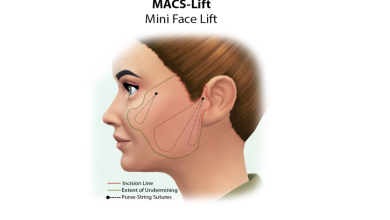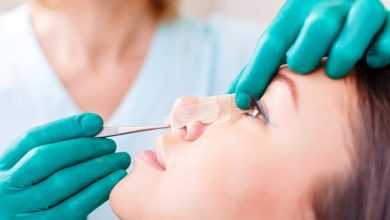What is Abdominoplasty (Tummy Tuck)?
Abdominoplasty, also known as “tummy tuck” can be defined as a surgical procedure intended to tighten the loose anterior abdominal wall skin and muscles between the breasts and the genital area and to eliminate skin sagging, in other words, it is the removal of excess and flabby abdominal skin and tightening of loose abdominal muscles to achieve a “flatter and tighter abdomen.”
Why is Abdominoplasty Performed?
In terms of aesthetic appearance, it can be extremely annoying for a person of normal weight to have deformations in the form of a convexity in the anterior abdominal wall region, flabby skin, and loose abdominal muscles, despite doing the necessary exercises, and such deformities can also impair the quality of life. With abdominoplasty, such problems can be eliminated, and then the self-confidence of people who have gained a tight and aesthetic abdominal appearance increases, they no longer face problems with choosing clothes, and they become more at peace with themselves and people in their environment.
What Are the Causes Sagging Abdominal Skin?
The main causes of loose abdominal muscles and sagging abdominal skin that require abdominoplasty:
- Rapid weight gain and loss
- Childbearing
- Aging
- Hereditary properties
- Surgeries performed in the abdominal region in the past
What Cannot Be Corrected With Abdominoplasty?
- The surgical procedure in question is not a weight loss surgery, so the surgery should be planned after the patient loses the excess weight by following appropriate diet and exercise programs.
- It is not an alternative to regular exercises, so you should pay attention to your exercise and diet after the surgery.
- If weight gain and loss or pregnancies are experienced after surgery, the deformation may recur to a certain extent.
- The procedure cannot eliminate stretch marks on the abdominal skin. However, the stretch marks on the excess abdominal skin are removed, and as a result, the stretch marks above that region are displaced downwards. In general, the stretch marks below the navel level are removed together with the skin, while the ones above the navel level are displaced downwards as the abdominal skin is stretched.
Characteristics of Candidates Who are Suitable for this Procedure
- They are completely healthy, both physically and mentally.
- They feel seriously uncomfortable with the appearance of their abdomens.
- They want the surgery for themselves, not for someone else or with intent to look like someone else.
- They are of normal weight, and they do not often experience excessive weight gain or loss.
- They don’t smoke.
- They have no thrombophlebitis (inflammation of a vein) or clot problems in their legs or a family history of such problems.
- Their expectations from the surgery are realistic.
- They have never had COVID-19.
What Are The Dos And Don’ts Before Surgery?
- The body mass index should be within or close to normal limits. The operation should be planned after the possible weight loss has been achieved.
- If the patient considers getting pregnant in the near future, the surgery should be postponed until after delivery.
- Smoking should definitely be stopped at least 1 month before the date of surgery.
- Blood thinners such as aspirin, vitamins, green tea, certain foods, special cures, and weight-loss diets should be discontinued 15 days before the operation.
- From 3 to 5 days before the operation, light foods and plenty of fluids should be consumed, and foods rich in fiber should be avoided. The night before the operation and on the morning of the operation, the intestines should be emptied using enemas recommended by the physician.
- If the patient or his/her family has a history of clot formation in the legs, the physician should definitely be informed.
- Birth control pills or treatments that involve the uses of hormones should be discontinued at least one month before the operation.
The Right Time for the Operation
- It should be the period when you are in the best condition both physically and mentally
- Your weight should be within normal limits
- Surgery should not be planned for a date right after a very tiring and stressful period, and you should rest for a period of at least one week before the surgery.
- After the operation, you should stay away intense work pressure for at least 1 month.
- If you have a chronic disease such as hypertension, goiter etc., it should be completely under control.
How is Abdominoplasty Performed?
Abdominoplasty is performed under general anesthesia by a Plastic, Reconstructive and Aesthetic Surgery Specialist under operating room conditions. As described in more detail below, an incision that can be in different lengths is made on the abdominal skin, the skin is lifted to expose the loose abdominal muscles, the muscles are tightened with the help of sutures, and then the excess part of the abdominal skin is removed. Abdominoplasty is not a monotype or standard operation, so it involves the use of different surgical techniques and incisions depending on the extent of the deformation in the abdomen.
What are the Types of Abdominoplasty?
- Mini abdominoplasty (also known as mini tummy tuck):
- Full abdominoplasty (also known as full tummy tuck):
- Circumferential abdominoplasty (also known as belt abdominoplasty, belt lipectomy, lower body lift, and extended abdominoplasty)
Mini Abdominoplasty (Mini Tummy Tuck)
- It is preferred especially in cases where the excess abdominal skin and the paunchy area are below the navel level.
- By making an incision a little longer than the cesarean section in the bikini area, the abdominal skin is lifted up to the navel level but the navel and higher parts are not interfered with.
- If necessary, the abdominal muscles in this area are tightened with the help of sutures.
- In addition, liposuction can be performed on the waist and the parts above the navel level in the same session.
- Compared to full tummy tuck surgery, it leaves shorter scars, takes less time, and its postoperative recovery process is faster.
Full Abdominoplasty (Full Tummy Tuck)
An incision is made from the bikini area to the sides, in such a way as to allow for the removal of the entire excess skin fold, the skin of the anterior abdominal wall is lifted up to the thoracic cage, and the navel is left in its original place.
- In a sense, an “inner corset” is applied by tightening the loosened abdominal muscles with the help of sutures.
- After the abdominal skin is pulled down, the excess skin and subcutaneous fat are removed.
- A new hole is made on the skin at the navel level, and the navel is re-positioned there.
- In this technique, excess skin both above and below the navel level is removed, and loose abdominal muscles are tightened.
Circumferential Abdominoplasty
- It involves the removal of excess skin not only from the anterior abdominal wall, but also from the waist and back.
- It is a procedure intended to eliminate sagging skin caused by excessive weight loss achieved with bariatric surgeries such as sleeve gastrectomy or by natural ways.
- The incision scar that runs horizontally may start from the bikini area and surround the entire body.
Post-Operative Healing Process
- At the end of the surgery, drain tubes are placed under the skin and then a corset is put on the patient
- The patient is positioned in a semi-sitting position with his/her knees bent and pulled toward the abdomen.
- As a precaution against clot formation in the legs, a massage tool is applied to the legs from the beginning of the surgery until the patient walks.
- 4 hours after the operation, the patient begins to consume soft foods and prompted to walk under the supervision of the nurse.
- To enable the lungs to expand sufficiently, breathing exercises are performed.
- The first postoperative night is spent in the hospital.
- There should be a companion at home to take care of the patient. The patient should only stand up to use the toilet and for short walks.
- Flatulent foods should be avoided, plenty of fluids should be consumed, and breathing exercises should be done.
- 10 days after the operation, the patient can take a bath and return to daily life gradually, provided that he/she wear the corset.
- It is necessary to wear an abdominal corset for a period of 6 weeks.
- Activities such as heavy sports, sunbathing and sauna should be avoided for 6 weeks.
- A variety of creams are applied to the surgical scar during its healing process, and it takes 1 to 2 years for the scars to take their final form. The surgical scar should be protected from the sun for at least one year.
- Numbness in the abdominal skin is normal, and gradually improves over months.
- The healing process after mini abdominoplasty is relatively faster.
Risks and Complications of the Procedure
- Anesthesia-related risks
- Blood or fluid accumulation under the skin
- Infection
- Those with pulmonary embolism (sudden blockage in a lung artery due to blood clot) or clot formation in their legs, those with a family history of disease, obese people, smokers, those who use birth control pills, those who receive hormone therapy, and those who have recently traveled more than 4 hours are at higher risk.
- Suture dehiscence
- Circulatory disorder and tissue loss in the abdominal skin (especially smokers are at higher risk)
- Numbness and sensory changes in the abdominal skin
- Enlargement or poor healing of the incision scars (hypertrophic scar, keloid)
- Asymmetry in the abdomen or incision scar
- Unsatisfactory results and need for revision surgery.
Duration of surgery
The operation takes 2 to 4 hours depending on the technique used and whether the session involves additional procedures.
Anesthesia Type
Abdominoplasty operations are performed under general anesthesia.
Does Abdominoplasty Require Additional Surgical Procedures?
In some patients, liposuction can also be performed to eliminate localized fat deposits in the waist regions in the same surgical session. In mini abdominoplasty, liposuction can be performed on the area above the belly button level and on the waist regions.
Is Any Other Surgical Procedure Required After Abdominoplasty?
In some patients, the amount of subcutaneous adipose tissue under the stretched skin may be higher than normal after the removal of the excess skin. In such a case, a more aesthetic result can be obtained if the excess subcutaneous adipose tissue under the remaining skin of the abdomen is removed with liposuction.
This liposuction procedure can be performed in conjunction with abdominoplasty in the same session or can be performed alone in another session later. In my own practice, I perform abdominoplasty alone, and if necessary, I perform the liposuction procedure at least 2 months later because it increases the risk of complications when performed in the same session.
Is It Safe To Get Pregnant After Surgery?
There is no harm in getting pregnant in the period following the surgery; on the contrary, the tightened anterior abdominal wall allows for better normal (vaginal) delivery. On the other hand, if there is a planned pregnancy, abdominoplasty should be postponed until after delivery, because the abdominal muscles and skin will get loose to a certain extent as a result of pregnancy.
Is Liposuction Alone Sufficient To Tighten the Abdomen?
The liposuction procedure can be sufficient in cases where the skin of the anterior abdominal wall is not saggy, the abdominal muscles are not loose, and there is only localized fat accumulation in the abdominal region.
However, liposuction is not an alternative to the abdominoplasty procedure, that is, it cannot fully recover the sagging skin or tighten the abdominal muscles. The procedure that can be more useful for solving your problems will be determined after the examination.
Is It Possible To Lose Weight With Abdominoplasty?
It is definitely not a weight loss procedure. First, we support our patients to get down to the lowest possible weight. When our patient says, “I can no longer lose weight” we evaluate the condition in terms of surgery. The more the weight of the patient to be operated is within normal limits, the more satisfactory the aesthetic result of the operation can be.
Therefore, it is more appropriate to have abdominoplasty in the period when the weight is stabilized after the weight-loss process. Weight losses after surgery may cause the abdominal skin and muscles to get loose again. On the other hand, weight loss will be equal to the weight of the surgically removed skin and subcutaneous adipose tissue, which can vary from approximately 500 to 1000 grams.
What are the Differences between Full Abdominoplasty and Mini Abdominoplasty?
In full abdominoplasty, the skin of the anterior abdominal wall is lifted above the navel level to expose and tighten all the loose abdominal muscles in the abdominal region, without changing the original location of the navel. In mini abdominoplasty, the abdominal skin is lifted up to the navel level only, and then the muscles below the navel level are tightened.
If necessary, a liposuction operation can be performed on the region above the navel level in the same session. In mini abdominoplasty, the scar that remains in the bikini area is shorter than in full abdominoplasty. Mini abdominoplasty is preferred especially in cases where the saggy and loose abdominal skin is below the navel level.
The Relationship between Abdominoplasty and Pregnancy
If the patient considers pregnancy, the abdominoplasty operation should be postponed because the abdominal muscles and skin will get loose again during the pregnancy period. After abdominoplasty we are asked some questions such as; “I had an abdominoplasty operation a short while ago, and now I found out that I’m pregnant. Should I have an abortion?”
The answer to this question is: “you can maintain your pregnancy because abdominoplasty does not adversely affect pregnancy”. In the literature, there are many studies supporting this response. Abdominoplasty can be performed 1 year after delivery.
Is There Any Non-Surgical Abdominoplasty Procedure?
If your body mass index is above normal, that is, if you are overweight, it is possible to reduce the paunch to a certain extent with just diet and exercises. However, if you are of normal weight, there is no non-surgical method for tightening your sagging skin.
How Long After Birth Can I Have Abdominoplasty?
If you breastfeed your baby, you can have abdominoplasty at least 6 months after the time of weaning. If you don’t breastfeed your baby, you can have the operation 1 year after delivery. In addition to these periods, it is beneficial for you to completely lose the weight that you gained during pregnancy and return to your normal weight before planning the surgery.
Abdominoplasty (Tummy Tuck) Prices in 2024
Abdominoplasty prices vary depending on the type of the abdominoplasty procedure to be performed, the hospital where the operation will be performed, and the surgeon who will perform the operation. You can contact our office to find out the abdominoplasty procedure appropriate for you and its cost.
References
Frequently Asked Questions (FAQ)
Does the Procedure Leave a Scar?
Does It Completely Flatten the Abdomen?
In abdominoplasty, the loose anterior abdominal wall muscles are tightened, and then the excess skin is removed to flatten the skin layer. If there is excessive accumulation of adipose tissue under the skin layer on the anterior abdominal wall, the liposuction procedure can be performed to reduce the fat layer under the skin, so that the abdominal region looks flatter. This liposuction procedure can be performed in conjunction with abdominoplasty or alone later. In my practice, I first perform abdominoplasty alone to minimize the risk of possible complications. After 1 to 2 months, I decide on whether there is a need for liposuction by evaluating the situation with my patient.
This procedure can be performed alone or in conjunction with another plastic surgery procedure such as breast lift. Another issue is that if the person’s weight is more than his/her ideal weight during the surgery, that is, he/she is overweight, he/she will look a bit paunchy due to the visceral fat mass accumulated around the intestines in the abdominal cavity. Such visceral adipose tissues can only be reduced by losing weight in natural ways. For this reason, first getting down to the ideal weight (losing excess weight by burning both the visceral and subcutaneous fat) and then having abdominoplasty allows for achieving a more successful aesthetic result on the first try.





